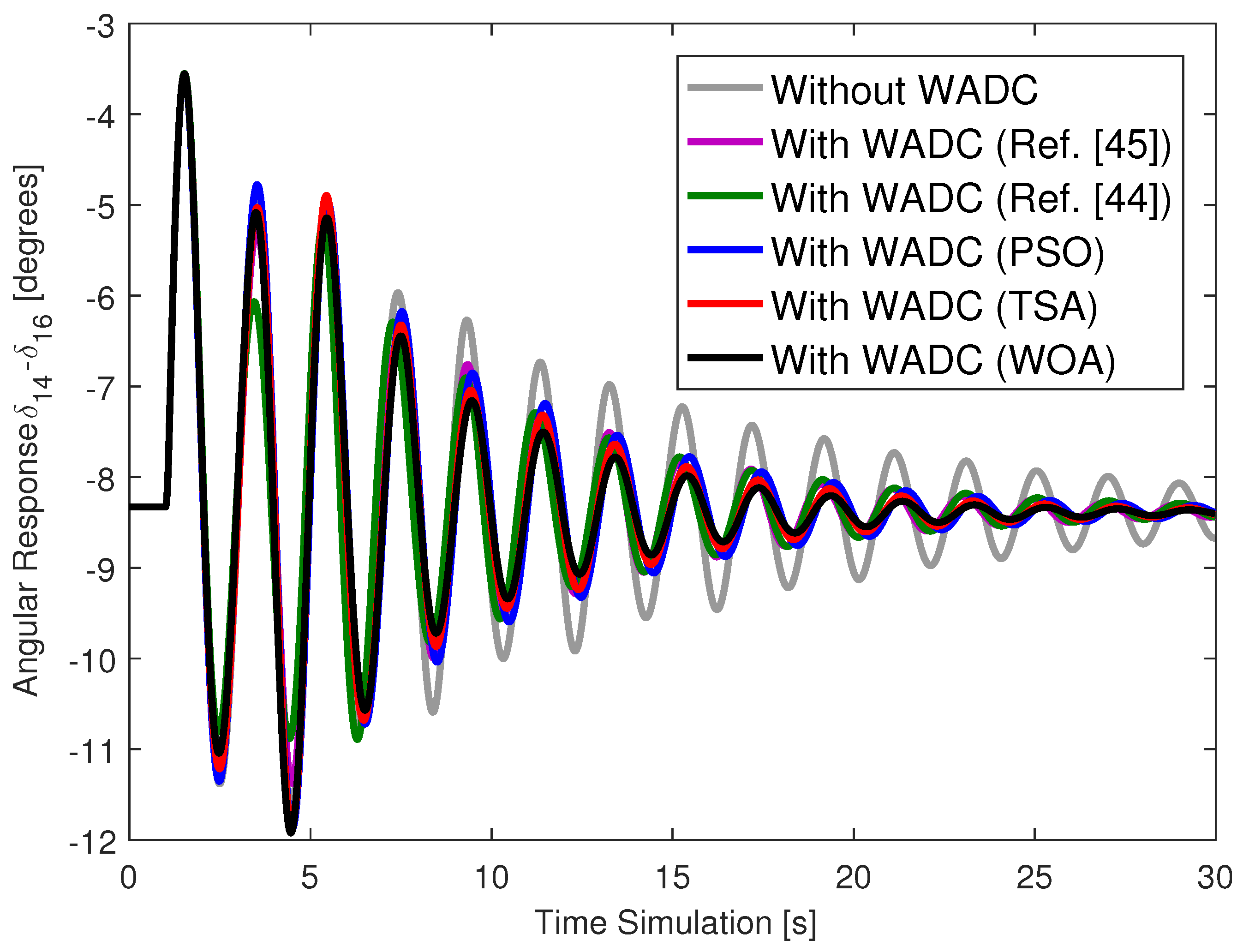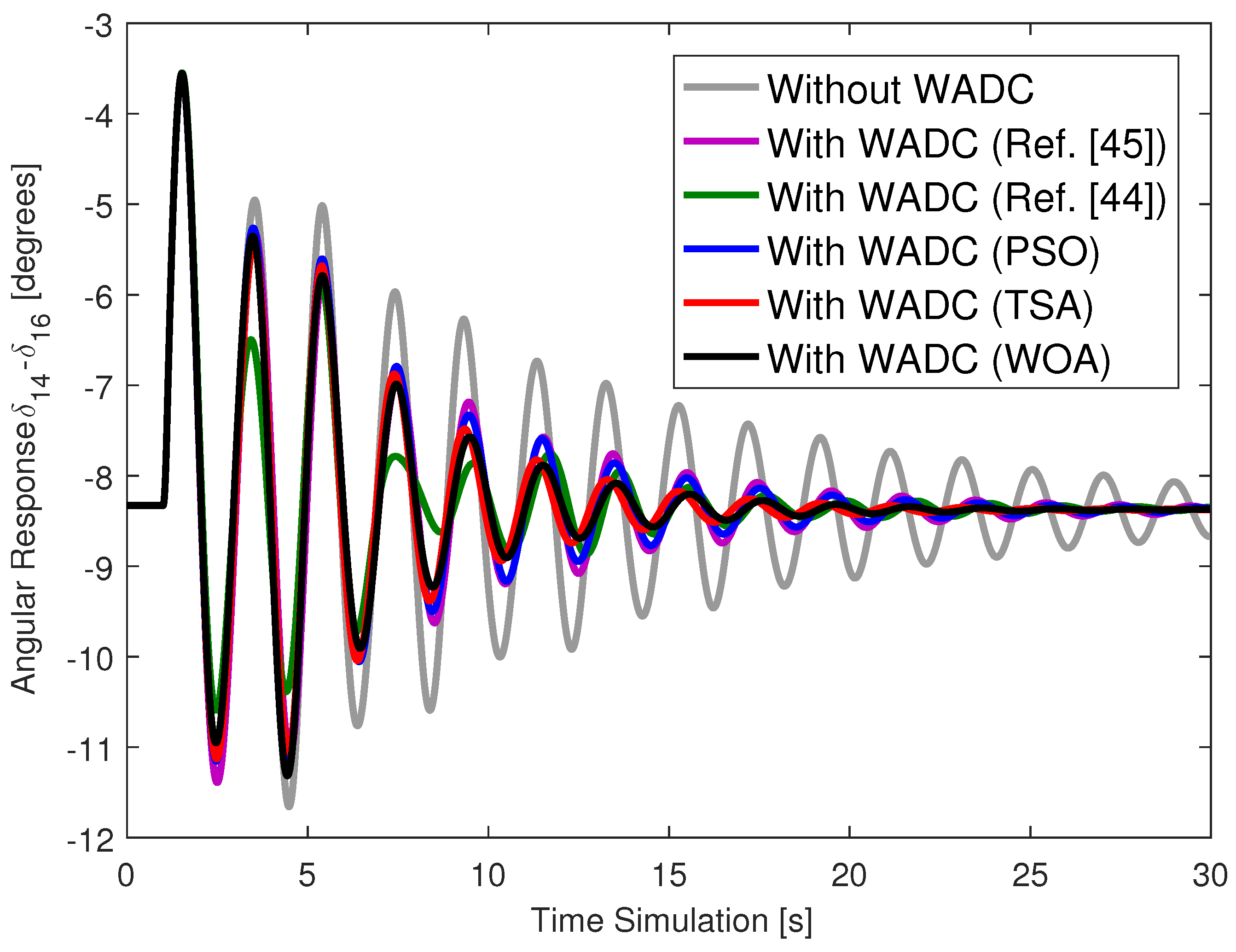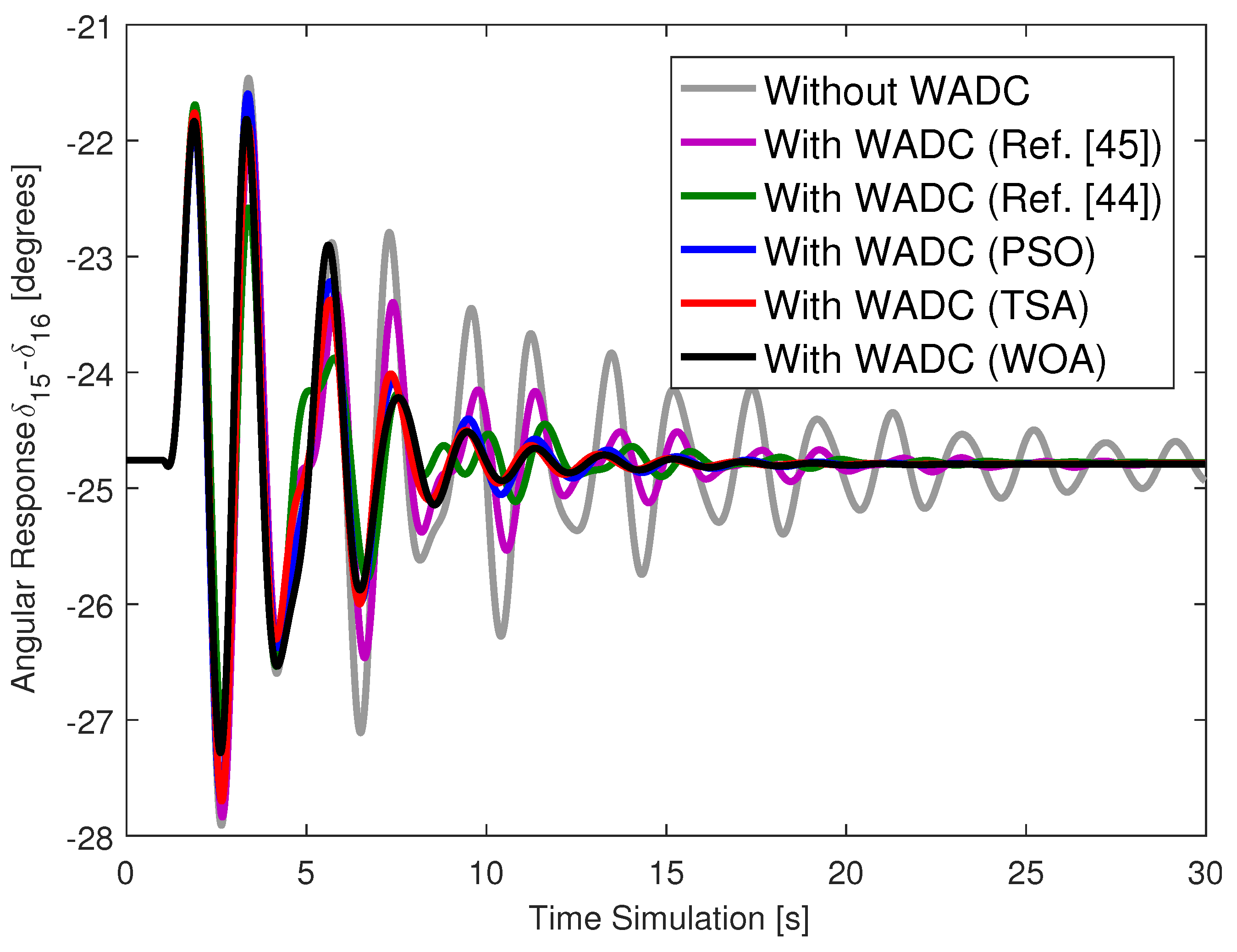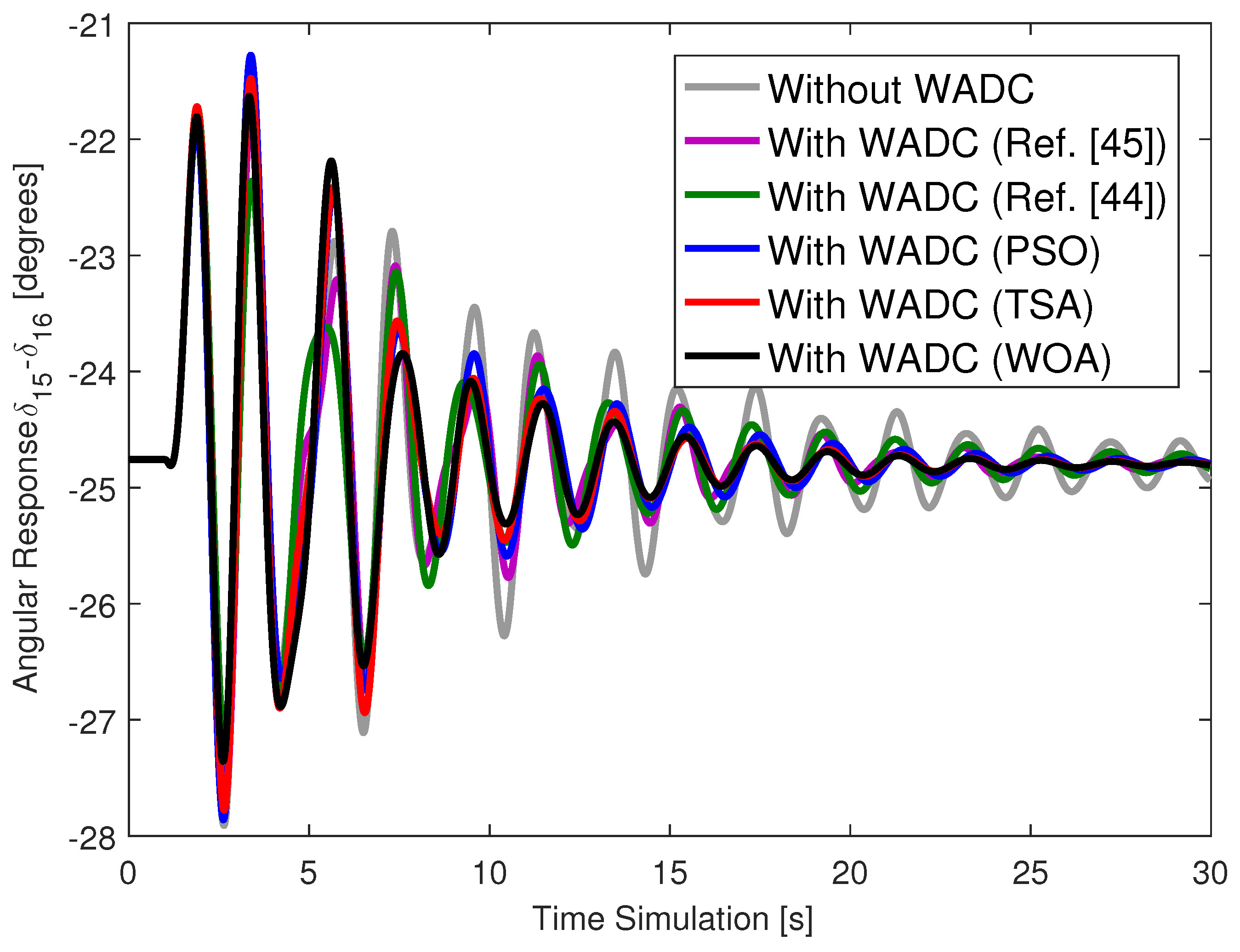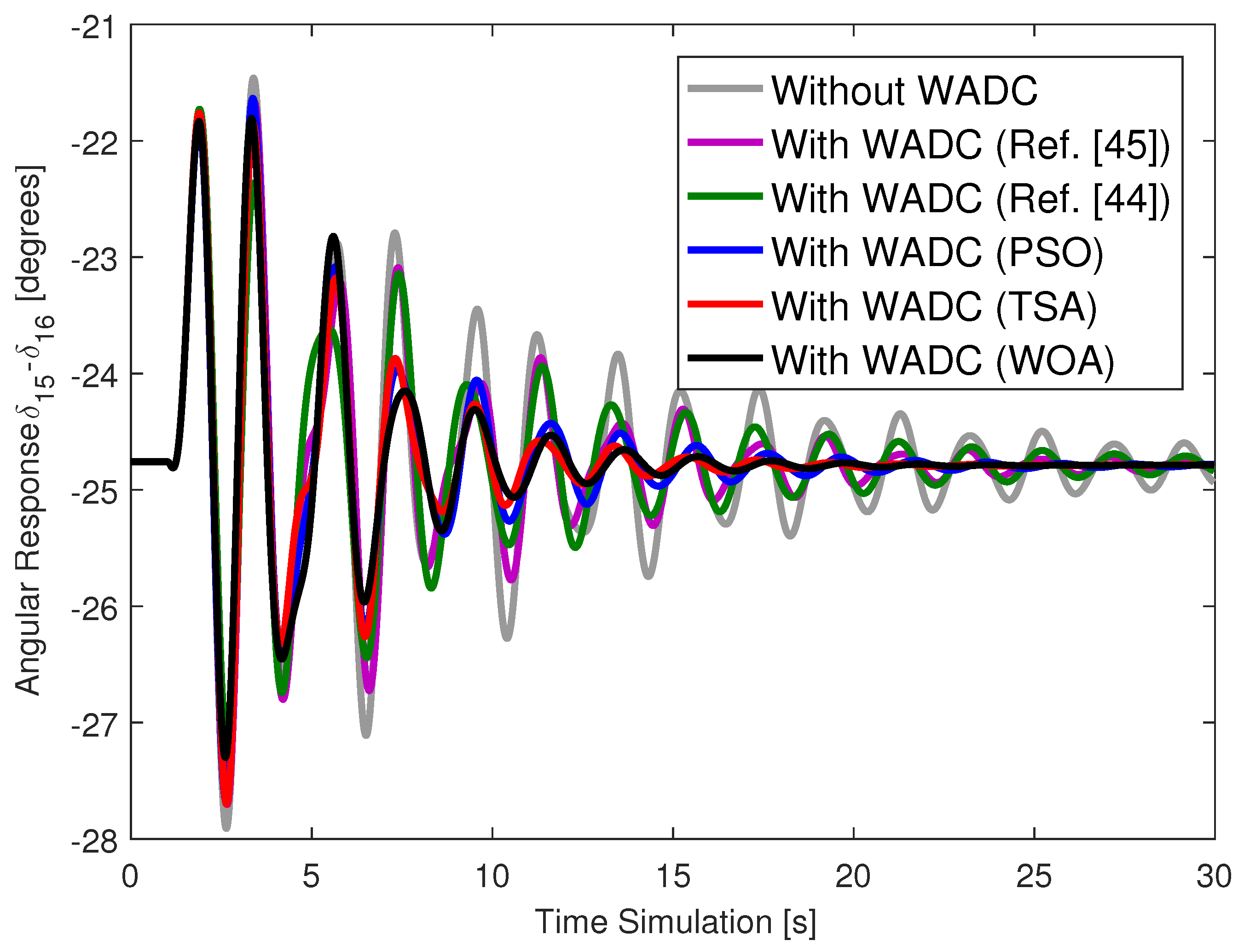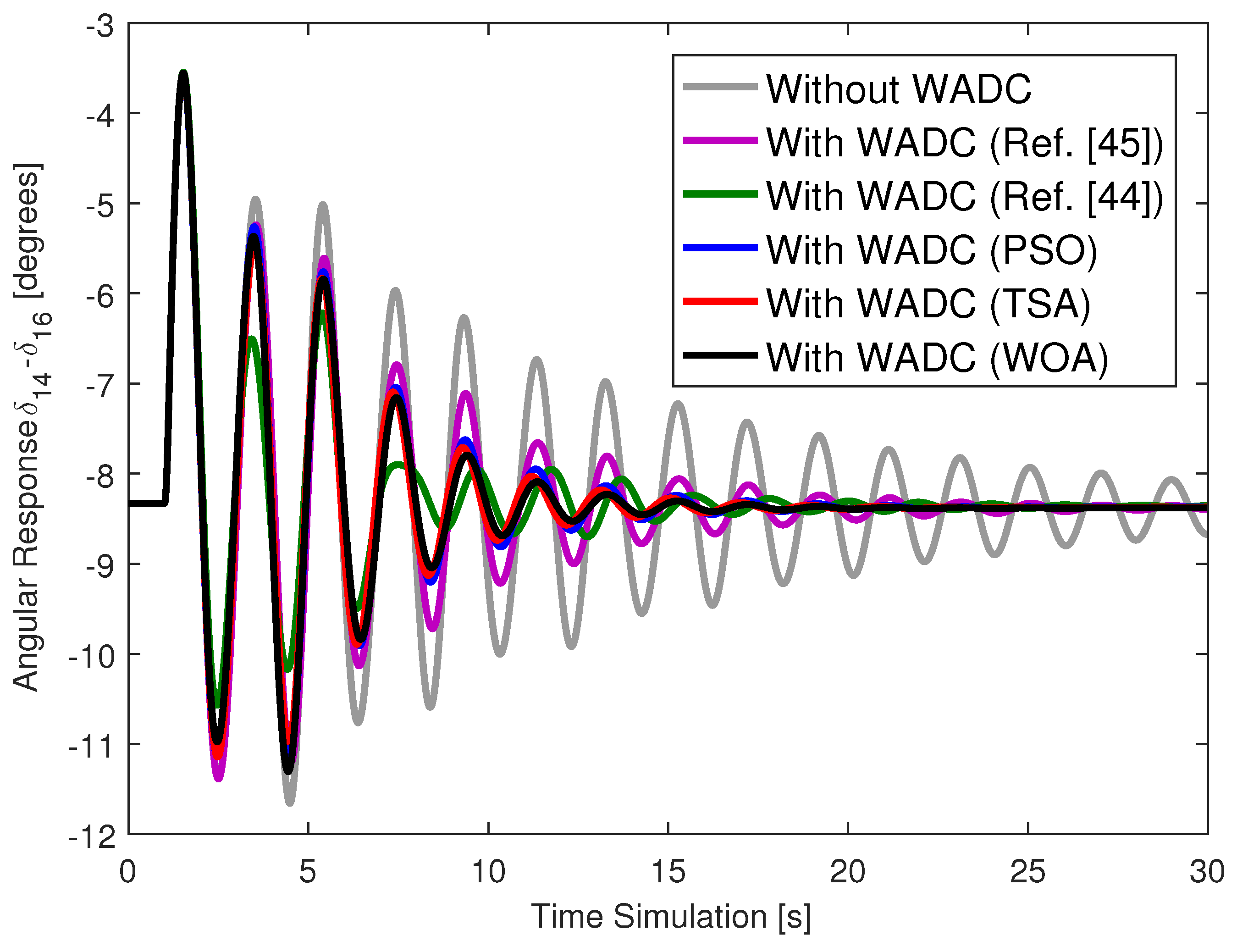1. Introduction
The evolution of power systems has accompanied the evolution of society. Advances in society have led to an increased dependence on and demand for electrical energy that require advances in power systems, such as new sources of energy generation, the expansion of transmission systems, and increasingly effective and reliable monitoring, control, and protection systems [
1]. Thus, the complexity of energy systems has evolved and new tools are needed to allow the desired system operation to be met, with the goals of low total economic cost and complete service to the load center [
1].
During the operation of a power system, different contingencies may occur and negatively affect power system performance. Some of these contingencies cause the emergence of low-frequency oscillation modes (LFOMs) with low damping ratios [
2]. The persistence of these modes with low damping ratios may even cause a system blackout; therefore, they need to be studied and mitigated [
3]. LFOMs are one of the branches of interest, and small-signal stability and damping control techniques are researched and developed to improve these damping ratios to desirable values [
3].
Power System Stabilizers (PSSs) are the main traditional damping controllers in power systems and are installed in the vicinity of the Automatic Voltage Regulators (AVRs) of synchronous generators [
3]. PSSs are local controllers and are effective in improving the damping rates of oscillation modes classified as local. Usually, the frequency of these modes is between 0.8 and 2 Hz. However, the expansion and complexity of modern power systems have worsened the damping rates of inter-area modes, where PSSs have limited effect due to the lack of system observability [
3]. Usually, the frequency of these modes is between 0.1 and 0.8 Hz. This scenario requires researching and developing new damping control strategies.
Over the years, new technologies have been applied to power systems to aid in their operation [
4]. Phasor Measurement Units (PMUs) are advanced meters that measure high rates of three-phase voltage and current signals and make these data available in time synchronization in a data concentrator [
5]. An optimal allocation of PMUs in the system allows a high degree of observability, which can be useful in several applications. In recent decades, the power system scientific community has proposed different tools for monitoring, control, and protection using PMU data [
6,
7,
8,
9,
10]. Several reports have been presented on the benefits of PMUs in systems, such as those from Brazil [
11], China [
12] and India [
13].
PMU data have shown promise for application in damping controller designs, especially due to the benefits of achieving greater system observability and high damping rates for inter-area modes. Usually, a damping controller that uses PMU data is called a Wide-Area Damping Controller (WADC) [
14,
15,
16]. There are some design and operation challenges related to a WADC compared to traditional PSSs, such as communication delays in the communication channels and cyberattacks or physical failures that can cause temporary or permanent communication failures.
A number of relevant WADC design methods deal with time delays, and the results presented are promising [
17,
18,
19,
20]. The authors of [
17] use a Pade approximation of a certain order to represent a transfer function through to the maximum data transmission delay. The authors of [
18] proposed an adaptive controller to deal with variable delays, while the authors of [
19] propose applying adequately designed compensators. A delay scheduling strategy was developed, tested, and discussed by the authors of [
20]. In [
21], the researchers propose a delay-handling strategy to deal with different data transmission delay rates. In [
22], the researchers present a delay-robust WADC design. In [
23], the authors apply theories of a correctly formulated Linear Matrix Inequality to evaluate the stability of a system subjected to time delays.
A recent concern in data-dependent PMU tools is their vulnerability to cyberattacks, which may impair the proper and guaranteed operation of the system and may even cause a widespread blackout. Recently, the Ukrainian power system was attacked by a False Data Injection attack that caused a blackout and significant social and economic losses [
24]. Since WADCs depend on data from PMUs, they are also vulnerable to various types of cyberattack [
25,
26,
27].
Some recent works have aimed at designing a WADC that is resilient to cyberattacks or communication failures. In [
28], the authors proposed to interrupt the operation of a WADC when a failure is detected, but this approach eliminates the desired and adequate damping benefits of having a WADC in the system. In [
29], the authors proposed to use redundant data in the lost communication channel, but this strategy has limitations and difficulties in complex scenarios. In [
30], the authors proposed a strategy capable of dealing with permanent communication failures; however, only one channel is considered and failures could occur in multiple communication channels. In [
31], the author proposes a WADC design method using coherency analysis to tolerate the communication losses. In [
32], the authors proposed a WADC design capable of dealing with Deception Attacks, but this controller has operating limitations. In [
33,
34,
35], the authors proposed a WADC design capable of dealing with False Data Injection Attacks. In [
36], the authors propose a WADC resilient to strong cyberattacks through a switching approach. Thus, there is a concern in the scientific community about designing WADC-type damping controllers that are robust to cyberattacks or communication failures.
The use of LQR theory for WADC design has gained prominence in recent years. An iterative method based on LQR is proposed in [
37], but good performance is only guaranteed for a single operating condition. Subsequently, the authors of [
38] discussed these limitations and the fact that this strategy cannot incorporate resilience into communication failures. The authors of [
39] developed the design of a STATCOM that operates with wide-area measurements using LQR but does not deal with uncertainties or communication failures. An approach to incorporate uncertainties into methods using LQR is discussed in [
40], but still does not consider communication failures. A two-stage algorithm is developed in [
41] to attempt resilience to communication failures, but the method has has difficulty converging in within a small number of iterations in large systems. A promising attempt to incorporate uncertainty into LQR-based techniques is presented in [
42], but it is difficult to achieve good damping ratios for LFOMs because the method aims only to reduce the inherent control effort. Furthermore, the approach requires an extremely precise definition of the Q and R matrices that comprise the technique. The authors of [
43] developed a modification of the LQR method, and the results demonstrate that uncertainties can be successfully addressed. Unfortunately, the method does not incorporate resilience to cyberattacks or communication failures. Recently, an optimization model using LQR theory was presented in [
44], but this technique presents convergence problems and produces a WADC with high gain values that can saturate the output signals and affect control performance. Furthermore, this technique does not benefit from model reduction methods, which are very useful in large systems. This method uses only genetic algorithms for its resolution and does not evaluate other metaheuristics for the convergence and performance tests of the designed WADC. A technique based on Linear Matrix Inequality (LMI) was developed in [
45] for the resilient design of a WADC, but this technique also presents design difficulties, as reported by the authors. The method presents many design variables that can hinder the convergence of the method. Furthermore, the designed WADC is of the same order as the plant, thus order-reduction techniques must be applied to reduce the WADC to enable the implementation of the WADC in the system. However, this order reduction of the WADC can cause the loss of the performance benefits achieved in the design, such as high damping ratio values, because the reduced WADC is not equal to the designed WADC.
This paper proposes a multi-objective optimization model whose variables are the WADC parameters and whose multi-objective function is to ensure that the two modes with the lowest damping ratios at each WADC operating point are close to the desired values. Resilience to permanent communication failures due to a well-formulated Denial-of-Service (DoS) attack sequence is incorporated into the linearized models of the closed-loop control system. Furthermore, order-reduction techniques were applied to improve the convergence of the proposed method based on LQR theory. The weight matrices associated with LQR theory are tuned by a bio-inspired algorithm. A comparative analysis was performed with three different bio-inspired algorithms: Particle Swarm Optimization (PSO) [
46], Tunicate Swarm Algorithm (TSA) [
47], and Whale Optimization Algorithm (WOA) [
48]. The IEEE 68-bus system was chosen to conduct evaluation studies of the proposed method through modal analysis and time-domain analysis.
Section 2 describes the power system model equipped with PMUs, the signal transmission delay model, the WADC model, the closed-loop control system, and the strategy to deal with cyberattacks that cause permanent communication failures.
Section 3 presents the proposed method with a step-by-step algorithm.
Section 4 shows the case studies of application of the proposed method describing and discussing the results.
Section 5 presents the conclusion of the article with possible future research.
3. Proposed Method
Determining the parameters of a WADC that is resilient to communication failures is the goal of this work. As presented in
Section 2.3, the closed-loop control system formulated as (
25) is equivalent to the system encompassing (
26) and (
27) if we apply an output feedback law given by (
32). Furthermore, if the poles of the WADC are fixed, then the matrices
,
, and
are fixed and the problem consists of finding
. In this research, the WADC design will be carried out by adopting an optimal control theory whose purpose is to minimize a quadratic index defined as a Linear Quadratic Regulator [
50]. This quadratic index is formulated as [
50]
where
is a positive semi-definite matrix and
is a positive definite matrix. The choices
and
affect the minimization of the index
.
The determination of the parameters of the WADC damping controller requires the resolution of the algebraic Riccati equation formulated in (
41). If we consider the state feedback control law formulated as (
38), the solution of this algebraic Riccati equation provides a unique optimal solution [
37].
where the vectors
and
have already been presented and
is the state feedback gain that satisfies
In this equation the matrix
is positive definite and symmetric, that is,
and this matrix is obtained by the algebraic Riccati equation
The
matrix that defines the WADC parameters is subsequently calculated as
In the WADC design,
,
, and
are fixed and known and the goal consists of finding
. Thus, the optimal control theory given by the Linear Quadratic Regulator can be applied to determine
as long as the matrices
and
are appropriately chosen. Furthermore, the power system’s size affects the dimensions of matrices
,
, and
, and consequently of matrices
,
, and
. The larger the size of these matrices, the greater the number of variables. Another interesting point is the fact that
,
, and
have many zero elements, which induces matrix
to also have zero elements and encounter difficulties in satisfying the algebraic Riccati equation. The solution found in this research was to apply the reduction model in [
51], which reduces the dimensions of matrices
,
, and
, and consequently of matrices
,
, and
. In addition, it assigns many non-zero elements to these matrices. Reduced models also reduce the processing time because there are fewer eigenvalue calculations and a smaller number of variables.
Section 3.1 discusses the multi-objective optimization model for choosing
and
and control performance requirements that must be met.
Section 3.2 describes the objective function in detail. Finally,
Section 3.3 briefly describes the bio-inspired algorithms.
3.1. Optimization Model
The proposed LQR-based algorithm aims to identify the WADC parameters by solving a multi-objective optimization model formulated as (
43)
where
and
are variable matrices in which only the elements of the main diagonal have nonzero values. Furthermore, the diagonal elements of
must respect the minimum (
) and maximum (
) limits, and the diagonal elements of
must respect the minimum (
) and maximum (
) limits. Another constraint imposed on this model is to ensure that the gains of each transfer function (
) respect minimum (
) and maximum (
) limits to avoid saturation of the control signals. The multi-objective function (
) is shown in
Section 3.2 and is related to meeting the damping ratio values for the modes with the lowest damping ratios. It is important to emphasize that LQR-based methods aim to minimize control effort and not necessarily to meet or improve the damping ratios of the LFOMs.
3.2. Objective Function
The multi-objective function of this optimization model is given by
where
and
are user-defined weights and
and
are predefined damping ratios for the first pair and the second pair of eigenvalues with smaller damping ratios.
Before applying the objective function, it is also necessary to define the set of
operating points and the nominal case (
,
) that will be evaluated by the algebraic Riccati equation. The algorithm presented below is an extension of the algorithm presented in [
37], with the addition of the formulation of resilience to communication failures.
The multi-objective function is determined by solving the following step-by-step algorithm from inputs and , which are the variables.
Step 1: The matrices and are initialized.
Step 2: Set
and
. Find
from the following algebraic Riccati equation
Step 3: Calculate
from
Step 4: Calculate
as
Step 5: Solve the following algebraic Riccati equation
Step 6: If for sufficiently small, then go to Step 7; however, if , then go to Step 3 and .
Step 8: Calculate
,
and
as
Step 9: Calculate the three closed-loop sets
,
,
for each of the
operating points.
for
,
, and
.
Step 10: Calculate all damping ratios after determining all eigenvalues of , , for all operating points.
Step 11: Calculate the lowest damping ratio and the second-lowest damping ratio for each one of the operating points and provide the smallest values and .
Step 12: Return the following objective function value
This step-by-step algorithm must be recalculated for each different value of and taken as variables of the optimization model.
3.3. Bio-Inspired Algorithms
Different techniques based on bio-inspired algorithms (BIAs) can be applied to solve the optimization model in (
43). In this research, three BIAs were applied and compared to evaluate the solving capacity of the optimization model. The three algorithms chosen were Particle Swarm Optimization (PSO) [
46], Tunicate Swarm Algorithm (TSA) [
47], and Whale Optimization Algorithm (WOA) [
48]. Bio-inspired algorithms such as PSO, TSA, and WOA have been successfully applied to various optimization problems, such as in [
52,
53,
54,
55,
56], and the results are promising, especially when the studies are performed offline. Bio-inspired algorithms present some difficulties when applied in real time. In this research, the WADCs will be designed offline and will not be designed in real time. The benefits of applying offline techniques include increased design time; thus, the convergence of the method can provide a WADC with better performance requirements. Furthermore, large systems may require large-scale linearized models. As a consequence, the method may require a longer processing time for adequate convergence, making its application in real time unfeasible.
4. Cases Studies
The proposed LQR-based method will be applied, analyzed, and discussed in the IEEE 68-bus system. In [
57], the authors present the nominal operation case (NOC); the two LFOMs with the lowest damping ratios in this nominal case are represented by M1 ad M2 in
Table 1. Furthermore,
Table 1 also presents a second operating case (OC2) relating to a 2% increase in the entire system load. Both operating cases present LFOMs with damping ratios well below 5% and, in addition, all four modes—M1, M2, M3, and M4—are inter-area modes. A suitable WADC design could decrease the control effort and increase the damping ratios of all oscillation modes in these operating cases.
Before applying the proposed method, we must choose the signals of the WADC. This system has 16 generators, but AVRs are only installed on generators 1 to 12 and can receive the control signals from the WADC. Applying the geometric controllability measures [
3] on the four oscillation modes of
Table 1, generators 12, 9, 11, 5, and 10 have high controllability rate values and will therefore be responsible for receiving output signals from the WADC. Applying the geometric observability measures [
3] onto the four oscillation modes of
Table 1, generators 12 to 16 will be responsible for sending the signals as inputs to the WADC. Thus, the WADC to be designed has 25 transfer functions that must be determined relative to the five input and output signals. It should be emphasized that the appropriate selection of WADC input and output signals is important because it affects the convergence of the method and the performance objectives of the closed-loop system. Large systems may have multiple LFOMs with low damping ratios, in addition to many synchronous generators equipped with AVRs. Therefore, the selection of signals and the number of signals is an essential task in the successful design of a WADC.
Now, the parameters of the proposed algorithm based on LQR theory must be defined. In this research,
,
,
,
,
,
,
= 10,000,
,
,
, and
. Two operating points were considered in the analysis: NOC and OC2. The case was considered as a nominal case and the poles of all WADC transfer functions were equal to
and
. Thus, the matrices
,
, and
were fixed. Bio-inspired algorithms have parameters that must also be defined. The three bio-inspired algorithms will have a population of 20 individuals, and the stopping criterion is a maximum of 1000 iterations. According to [
46], the PSO algorithm will have the following parameters:
,
, and
and
and
are random values in [0, 1]. According to [
47], the TSA algorithm will have the following parameters:
,
, and
, and
and
are random values in [0, 1]. According to [
48], the WOA algorithm will have the following parameters:
, and
,
is a vector with appropriate dimensions and values in [0, 1].
A comparative analysis was conducted with a method [
44] already published in the literature. This method presents differences in relation to the method proposed in this research. The method in [
44] does not consider gain limits for the WADC transfer functions, which can cause saturation of the WADC output control signals. Furthermore, this method [
44] aims to maximize the damping ratio of the smallest eigenvalue, which can lead to a reduction in the damping ratios of the other modes of the system, and these modes can compromise the angular response. The method in [
44] does not use order-reduction techniques; thus, it works with a larger number of variables and requires more processing time.
BIAs may present different convergence results for each simulation of the same algorithm. Thus, 100 different simulations for each BIA were performed.
Table 2 presents the standard deviation, maximum, average, and minimum results of the objective function.
For modal analysis studies and dynamic simulations, a WADC resulting from each of the bio-inspired algorithms was chosen.
Table 3,
Table 4 and
Table 5 present the numerator parameters of each of these WADCs. It should be noted that the poles were fixed in the simulation and equal to
and
. Therefore, the denominator of each transfer function is
.
Table 6 presents WADC parameters after applying the method in [
44].
Table 7 presents the WADC parameters after applying the method in [
45].
Each WADC can provide different eigenvalues for the whole system and consequently different damping ratios. Thus, a modal analysis was conducted.
Table 8,
Table 9 and
Table 10 provide the LFOMs for each operation case, with or without the loss of communication signals, and for each WADC.
Table 11 also provides these LFOMs for WADC designed using the method in [
44].
Table 12 provides these LFOMs for WADC designed using the method in [
45].
The WADC design was performed using linearized models. Thus, dynamic analyses must be conducted. These dynamic analyses were conducted in ANATEM software [
58] with the application of a contingency. The AVRs, PSSs, and WADC present output signal limiters. A short circuit was applied to the IEEE 68-bus system at bus 40 with a duration of 100 ms. The angular response of generator 14 is described in
Figure 1 for the system with different WADCs and without the WADC. The failure of the WADC was also evaluated in these simulations. The same short circuit was applied and, in addition, the communication channel related to the speed signal of generator 16 was permanently lost. The angular response of generator 14 is described in
Figure 2 for the system with different WADCs and without the WADC. A second failure case was evaluated: the failure of the channel responsible for sending the control signal to generator 5. The angular responses are described in
Figure 3 for the system with different WADCs and without the WADC.
Dynamic simulations were conducted in a second operating case: case OC2 with disconnection of transmission line 31–53. A circuit was temporarily applied to bus 40 for 100 ms. The angular responses for this case without the WADC and with the WADC operating without communication failures are presented in
Figure 4.
Figure 5 presents the angular responses for this same case with loss of the speed signal (WADC input channel) from generator 16.
Figure 6 presents the angular response of generator 15 for this same case with the loss of the WADC control output signal going to the AVR of generator 5.
The different results achieved in the case studies allow the following critical evaluations
The three BIAs presented low objective function values, as desired in this minimization problem. As reported in
Table 2, the WOA algorithm presented the lowest values in the 100 different simulations (values between
and
) and even presented the lowest standard deviation (
), evidencing a more uniform convergence. The PSO had difficulty achieving low multi-objective function values; the values were between
and
.
The damping ratios of the first pair of eigenvalues of the system were above 5%, as desired for all WADCs (PSO, TSA, and WOA) and reported in
Table 8,
Table 9 and
Table 10. Again, the WADC provided by WOA gave the best damping ratios. Furthermore, the second pair of poles also presented damping ratios higher than 6%, as desired in the multi-objective optimization model. The design wanted the first pair of poles to be close to 6% (
) and the second pair to be close to 8% (
).
Dynamic simulations of the system with contingency application without WADC and with the different WADCs (PSO, TSA, and WOA) showed better damped angular responses with WADC, as described in
Figure 1 and
Figure 4.
Dynamic simulations also show that the WADC was resilient even when a single failure occurred either at the input or output of the WADC, as described in
Figure 2,
Figure 3,
Figure 5 and
Figure 6. Communication failures do affect angular responses, but the strategy adopted in this research ensured that the system with the different WADCs had well-damped angular responses.
The WADC designed using the technique in [
44] did not present high damping ratio values for all LFOMs. This technique presented convergence difficulties because it does not use reduced-mode models of the system. Furthermore, this technique aims to increase the minimum damping of the system and ended up drastically reducing the damping of the other modes. The WADC gains had high values (above 80). The angular responses of the system with this WADC prove to be poorly damped when compared to the WADCs of the proposed method.
The WADC designed using the technique in [
45] also resulted in poorly damped angular responses and design difficulties. There are several reasons for these design difficulties and the limited performance. The technique in [
45] has many variable matrices to determine, making convergence difficult. Furthermore, convergence results in a WADC of the same order as the system, and thus this controller needs to be reduced. The order-reduction technique can lead to a loss of performance requirements. The technique in [
45] guarantees a minimum damping ratio only for the mode with the lowest damping ratio; thus, the other modes can have their damping ratios reduced.
